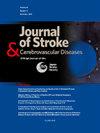小动脉闭塞致轻度脑卒中早期神经功能恶化:发生率、危险因素及治疗影响
IF 2
4区 医学
Q3 NEUROSCIENCES
Journal of Stroke & Cerebrovascular Diseases
Pub Date : 2025-04-25
DOI:10.1016/j.jstrokecerebrovasdis.2025.108331
引用次数: 0
摘要
早期神经功能恶化(END)是轻微中风预后不良的预测因素。END在小动脉闭塞(SAO)引起的轻微卒中中的患病率和预测因素尚不清楚。患者和方法我们回顾性分析了在巴赫迈医院卒中中心住院的451例由SAO引起的24小时内的轻度卒中(NIHSS≤5)患者。END被定义为在最初72小时内出现两个或两个以上NIHSS点升高的情况。主要结局包括确定END发生率。次要结局通过多变量logistic回归分析确定了END的预测因素,以及抗血小板和溶栓治疗的治疗效果。结果send发生率为9.5%(43/451),其中男性62.7%,平均年龄63.8±11.8岁。独立预测包括入院收缩压≥150mmhg (OR = 1.99;95% ci: 1.01 - 3.94;p = 0.048)、糖尿病史(OR = 0.58;95% ci: 1.05 - 4.33;p = 0.036),入院血糖≥14mmol/L (OR = 2.99;95% ci: 1.05 - 8.54;p = 0.04),内囊梗死(OR = 2.23;95% ci: 1.01 - 4.92;P = 0.048)。在4.5 h内入院的患者组,与SAPT相比,DAPT的END风险显著降低(OR = 0.079;95% ci: 0.007 - 0.939;p = 0.04)和altepase (OR = 0.013;95% ci: 0.01 - 0.12;p & lt;0.01)。SAPT和altepase的END风险相似(p = 0.074)。讨论与结论在SAO引起的轻微急性缺血性脑卒中中end的发生率为9.5%。独立的预测是入院收缩压和血糖、糖尿病史和内囊梗死。DAPT组的END风险明显低于SAPT和阿替普酶组。本文章由计算机程序翻译,如有差异,请以英文原文为准。
Early neurological deterioration in minor stroke caused by small artery occlusion: Incidence, risk factors and treatment impact
Introduction
Early neurological deterioration (END) is a forecast factor in poor outcomes in minor strokes. END's prevalence and forecast factors in minor strokes caused by small artery occlusion (SAO) are still unclear.
Patients and Method
We retrospectively analyzed 451 patients with minor stroke (NIHSS ≤ 5) caused by SAO hospitalized within an initial 24 h at BachMai Hospital's stroke center. END was defined as conditions with an elevated two or more NIHSS points within an initial 72 h. The primary outcome included the determination of the END incidence. The secondary outcome identified forecast factors for END through multivariate logistic regression analyses, and therapeutic impacts of antiplatelet and thrombolytic treatments.
Results
END occurred in 9.5 % (43/451) of patients (62.7 % male, mean age 63.8 ± 11.8 years). Independent forecast included admission SBP ≥ 150 mmHg (OR = 1.99; 95 % CI: 1.01 - 3.94; p = 0.048), diabetes history (OR = 0.58; 95 % CI: 1.05 - 4.33; p = 0.036), admission blood glucose ≥ 14mmol/L (OR = 2.99; 95 % CI: 1.05 - 8.54; p = 0.04), and internal capsule infarction (OR = 2.23; 95 % CI: 1.01 - 4.92; p = 0.048). The patients group admitted within 4.5 h, DAPT has significantly lower END risk compared to SAPT (OR = 0.079; 95 % CI: 0.007 - 0.939; p = 0.04) and altepase (OR = 0.013; 95 % CI: 0.01 - 0.12; p < 0.01). END risk was similar between SAPT and altepase (p = 0.074).
Discussion and Conclusion
END is a 9.5 % incidence in minor acute ischemic stroke due to SAO. Independent forecasts are admission SBP and blood glucose, diabetes history, and internal capsule infarction. The DAPT group has significantly lower END risk than the SAPT and alteplase groups.
求助全文
通过发布文献求助,成功后即可免费获取论文全文。
去求助
来源期刊

Journal of Stroke & Cerebrovascular Diseases
Medicine-Surgery
CiteScore
5.00
自引率
4.00%
发文量
583
审稿时长
62 days
期刊介绍:
The Journal of Stroke & Cerebrovascular Diseases publishes original papers on basic and clinical science related to the fields of stroke and cerebrovascular diseases. The Journal also features review articles, controversies, methods and technical notes, selected case reports and other original articles of special nature. Its editorial mission is to focus on prevention and repair of cerebrovascular disease. Clinical papers emphasize medical and surgical aspects of stroke, clinical trials and design, epidemiology, stroke care delivery systems and outcomes, imaging sciences and rehabilitation of stroke. The Journal will be of special interest to specialists involved in caring for patients with cerebrovascular disease, including neurologists, neurosurgeons and cardiologists.
 求助内容:
求助内容: 应助结果提醒方式:
应助结果提醒方式:


